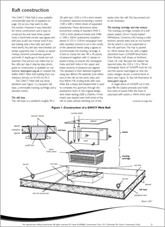Your ability to assess how your mink trapping impacts on mink numbers and how that translates into conservation benefits, will be enhanced if you keep detailed records of your rafts, especially of tracks found during monitoring mode. It’s not the number of mink you remove that matters, but how much of the time the river is free of mink. This is the evidence that will motivate your funders to support the project, and convince the public that this is the right course of action.
For operational and river maintenance purposes, the Environment Agency (EA) needs to know where mink rafts are being used. If you are planning to use mink rafts, please contact the EA’s local offices. There is a small theoretical risk of a raft causing obstruction to a sluice or other drainage control structures, resulting in flooding and extra maintenance work. In practice, we are not aware of any instance where this has occurred, as the raft is a small structure compared with trees and other common flotsam. Nevertheless, the legal situation is that the raft operator could be open to prosecution by the drainage board if these circumstances arose.
Similarly, environmental pollution by raft materials is not really an issue, as rafts which break loose in flood conditions are generally easy to retrieve in large pieces. However, morally as well as legally, the operator should assume full responsibility for the raft while it remains on the water. It is advisable to ‘retire’ rafts after three years, rather than risking them breaking up at the next spate.
You should also be conscious of the risk of carrying disease (e.g. fungal fish diseases, crayfish plague) from one river to another on any wet equipment. This includes rafts and waders. The best form of disinfection is to thoroughly dry equipment for a minimum of 48 hours. Drying in sunlight is the most effective option. A raft will take a long time to dry unless it is completely dismantled. Iodine-based preparations (e.g. Iodophor, from veterinary suppliers or online services) are also recommended for disinfecting equipment. Iodophor contains iodine and phosphoric acid, so read the safety data.
Get your FREE Mink Raft Plans today
 The award-winning GWCT Mink Raft was developed both as a means of detecting mink, and as a favourable trap site.
The award-winning GWCT Mink Raft was developed both as a means of detecting mink, and as a favourable trap site.
What you can download for free
✓ Mink Raft Guidelines
✓ Instructions & Plans
✓ How to Build the GWCT Mink Raft
* By submitting your email address you are giving your consent to receive emails from the GWCT about our work with the opportunity to unsubscribe at any time.